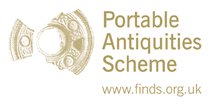Not all archaeological discoveries come from excavation or fieldwork. Every year, many thousands of archaeological objects are discovered by members of the public; mostly by metal detectorists but also by people who are out walking, gardening or going about their daily work. We use the term “portable antiquities” to distinguish these objects from those found through organised archaeological fieldwork.
Often these finds will be the only evidence for human activity in an area but once they are removed from the ground that evidence is lost. That is unless it is properly recorded, which is where the Portable Antiquities Scheme comes in! The Portable Antiquities Scheme (or PAS) is a project that encourages the recording of these archaeological objects found by members of the public. It is run by the British Museum and by Amgueddfa Cymru – National Museums Wales. By recording these archaeological finds onto our database, the PAS is able to preserve the archaeological information and make it available for everybody to research.
These objects are not only important for telling us about past peoples and the types of objects they used, but also about the places where they lived and worked. By sharing the archaeological information recorded by the PAS we can help people to learn more about the archaeology and history of their local area.
What happens when an archaeological object is discovered by a member of the public?
When a member of the public discovers an archaeological object, they can bring it to their local Finds Liaison Officer (or FLO) to find out more about it. The FLO will help identify what it is and whether it should be recorded by the Scheme.A Finds Liaison Officer is an archaeologist who specialises in the identification and recording of archaeological objects. They research and record archaeological objects found by members of the public and help them to learn about the archaeology of their local area.

What sort of objects does the Portable Antiquities Scheme record?
For an object to be recorded onto the PAS database it must:
- Date to AD 1540 or earlier
- Be made or modified by humans (so no fossils please!)
- Not be from an organised archaeological project
Sometimes if an object dates to later than AD 1540 but is very significant or has a good local connection we will also record it because it adds important information to the history of an area.
An object does not have to be made of metal to be recorded. Most of the objects on the database are metallic because they have been found using a metal detector, but we are interested in seeing objects made from all materials. The database includes items made from stone, ceramics, wood, leather and bone.
The PAS also deals with a special category of finds known as Treasure (with a capital ‘T’). These are objects that meet a specific set of criteria as defined by law in the Treasure Act 1996. Any items suspected to be Treasure must be reported by law as it is illegal to knowingly conceal Treasure and can lead to prosecution and even prison. To find out more about Treasure and the Treasure Act visit our Treasure pages, or speak to your local Finds Liaison Officer. A full list of FLOs can be found here.

How do we record an archaeological object?
All finds recorded by the PAS, including Treasure, will have a database record created for them. We do not keep the actual finds, just the data about them. This is known as preservation by record and it is important that each object is recorded in as much detail as possible, in order to be of use to future researchers. Every database record contains the following information:
- A unique ID number
- Object Type – what the object is
- Description – a detailed description of what the object looks like. This is important because researchers will not have the object in front of them
- Date – when the object was made
- Measurements – size, weight and quantity (of more than one)
- Materials – the main material from which it is made
- Discovery details – how it was discovered, when, where and by whom
- Images – photographs of the object from multiple angles to show all of the important features
All of the information about the objects is stored on the PAS database, which can be accessed here. We record around 70,000 objects a year and there are currently more than 1.5 million objects on the database. This information is available for everybody to use so that anyone can find out about the archaeology of England and Wales. The database is an amazing resource for researchers of all ages!




